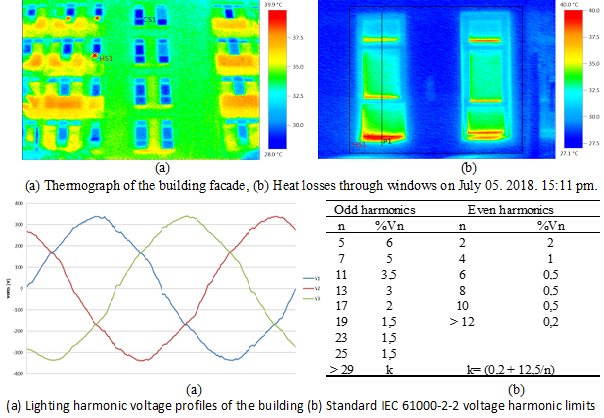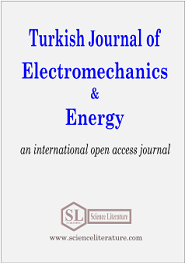
Energy saving potential and energy audit of a faculty building at Marmara University in Türkiye
Abstract
According to the Council of Higher Education's records in 2022, one hundred thirty-one public universities operate in Turkiye. If the energy efficiency in faculty buildings is improved by 20%, 1.458 million U.S. dollars savings per year would be possible. This paper presents the energy profile and energy audit of the Faculty of Technology at Marmara University, in Istanbul Türkiye. The energy efficiency opportunities for faculty building are investigated depending on the energy audit results. The fact that the faculty building is uninsulated therefore this situation causes severe energy losses. The annual heating energy requirement of this university building, which has an average construction area of 15,000 m², is 297,728 kWh. Only an average of 56,987 kWh in fuel consumption and up to 20% energy savings can be achieved with thermal insulation. However, when the existing lighting fixtures are replaced with Light Emitting Diode (LED) fixtures, the annual savings amount is $6,198. The results of this study enable search of sustainable solutions for reducing energy consumption and improving energy audits for faculty buildings.
Full Text:
PDFReferences
V. Ediger, G. Kirk, E. Celebi, M. Ucal, C. Kent-Cin, “ Turkish public preferences for energy,” Energy Policy, vol. 120, pp. 492-502, 2018.
“Turkish Official Gazette,” Feb. 20 2012 [Online]. Available: http://www.resmigazete.gov.tr/eskiler/2012/02/20120225-7.htm. [Accessed: April 23, 2021].
Anonym, “Republic of Turkey Ministry of Energy and Natural Resources,” Available: http://www.enerji.gov.tr/File/?path=ROOT%2f1%2fDocuments%2fSayfalar%2fenver_gelisim_rapor_2018.pdf. [Accessed: April 14, 2021].
Anonym, “Turkish Statistical Institute (TUIK),” [Online]. Available: http://www.turkstat.gov.tr. [Accessed April 10 2018].
Anonym, “Republic of Turkey Ministry of Energy and Natural Resource,” [0nline]. Available: http://www.yegm.gov.tr/document/KamuBinalariRaporu_2018.pdf. [Accessed: May 01 2018].
I. Berk and V. Ediger. “A historical assessment of Turkey’s natural gas import vulnerability,” Energy, vol. 145, pp. 540-547, 2018.
O. K. Kabakçi, “Evaluation of on-site production possibilities in different building typologies in Turkey within the framework of energy efficiency.” [Online] Available: http://www.etkuzmanlari.org/wp-content/uploads/2018/01/Binalarda-Yerinde-%C3%9Cretim-ve-Enerji-Verimlili%C4%9Fi.pdf. [Accessed: April 10, 2021].
C. Koulamas, A. Kalogeras, R. Pacheco-Torres, J. Casillas, L. Ferrarini, “Suitability analysis of modeling and assessment approaches in energy efficiency in buildings,” Energy and Buildings, vol. 158, pp. 1662-1682, January 2018.
Anonym, “Thermal Insulation Requirements for Buildings”. May 2008. [Online] Available: https://sayfam.btu.edu.tr/upload/dosyalar/1458664642TS-825_Standard.pdf [Accessed: April 23, 2018].
L. Yang, K.L. Wang, J.C. Geng, “China's regional ecological energy efficiency and energy saving and pollution abatement potentials: An empirical analysis using epsilon-based measure model,” Journal of Cleaner Production, vol.194, pp.300-308, 2018.
V. Oikonomou, F. Becchis, L. Steg, D. Russolillo, “Energy saving and energy efficiency concepts for policy making,” Energy Policy, vol.37, pp. 4787-4796, 2009.
D. Giuliano, “Green Energy Audit of Buildings. A guide for a sustainable energy audit of buildings,” Springer-Verlag, London, 2013.
L. F. Cabeza, D. Ürge-Vorsatz, A. Palacios, D. Ürge, C. Barreneche, “Trends in penetration and ownership of household appliances,” Renewable and Sustainable Energy Reviews, vol. 82, pp.4044-4059, 2018.
A. N. Akpolat, E. Dursun, A. E. Kuzucuoğlu, Y. Yang, F. Blaabjerg, “Performance analysis of a grid-connected rooftop solar photovoltaic system,” Electronics, vol.8, pp.905, 2019.
J. Windarta, C. Radityatama, E. Handoyo, “Analysis of Energy Consumption Intensity and Electric Power Quality in UNDIP Campus," In Proc. of the 6th Int. 4th International Conference on Energy Conservation and Efficiency (ICECE), Lahore, Pakistan, March 16-17, 2021.
L. Bellia, M. Borrelli, R. F. De Masi, S. Ruggiero, G. P. Vanoli, “University building: Energy diagnosis and refurbishment design with cost-optimal approach. Discussion about the effect of numerical modelling assumptions,” Journal of Building Engineering, vol. 18, pp. 1-18, July 2018.
D. Rekioua, S. Belaid, T. Rekioua, “Sizing and technical study of a solar photovoltaic/thermal system: Application in Bejaia area,” Turkish Journal of Electromechanics & Energy. vol.7(1), pp. 3-14, 2022.
Marmara University web side [Online]. Available: http://www.marmara.edu.tr/universite/yerleskeler/ [Accessed May 20. 2018].
B. Tarroja, F. Chiang, A. AghaKouchak, S. Samuelsen, T. Hong, “Translating climate change and heating system electrification impacts on building energy use to future greenhouse gas emissions and electric grid capacity requirements in California,” Applied Energy, vol. 225 (c), pp. 522-534, 2018.
M. Premrov, V. Z. Leskovar, K. Mihalič, “Influence of the building shape on the energy performance of timber-glass buildings in different climatic conditions,” Energy, vol. 108. pp.201-211, 2016.
H. Zhou, B. Lin, J. Qi, L. Zheng, Z. Zhang, “Analysis of correlation between actual heating energy consumption and building physics. heating system. and room position using data mining approach,” Energy and Buildings, vol.166, pp. 73-82, 2018.
F. Alzetto, G. Pandraud, R. Fitton, I. Heusler, H. Sinnesbichler, “QUB: A fast dynamic method for in-situ measurement of the whole building heat loss,” Energy and Buildings, vol. 174, pp. 124-133, 2018.
M. Zinzi, E. Carnielo, B. Mattoni, “On the relation between urban climate and energy performance of buildings. A three-years experience in Rome, Italy,” Applied Energy, vol.221, pp.148-160, 2018.
S. Firląg and B. Zawada, “Impacts of airflows. internal heat and moisture gains on accuracy of modeling energy consumption and indoor parameters in passive building,” Energy and Buildings, vol. 64, pp. 372-383, 2013.
D. A. Chwieduk, “Towards modern options of energy conservation in buildings,” Renewable Energy, vol. 101, pp. 1194-1202, 2017.
Thermal Insulation Requirements in Buildings, Turkish Standard 825, [Online] Available: http://www1.mmo.org.tr/resimler/dosya_ekler/cf3e258fbdf3eb7_ek.pdf [Accessed: May 15, 2018].
International Organization for Standardization, [Online] Available: https://www.iso.org/standard/40966.html [Accessed May 15, 2018].
M. N. M. Tumbaz, H. T. Mogulkoc, “Profiling energy efficiency tendency: A case for Turkish households,” Energy Policy, vol. 119, pp. 441-448, 2018.
J. A. Lobão, T. Devezas, J. P. S. Catalão, “Energy efficiency of lighting installations: Software application and experimental validation”, Energy Reports, vol. 1, pp. 110-115, 2015.
I. Azcarate, J. J. Gutierrez, A. Lazkano, P. Saiz, L. A. Leturiond, “Towards limiting the sensitivity of energy-efficient lighting to voltage fluctuations,” Renewable and Sustainable Energy Reviews, vol. 59, pp. 1384-1395, 2016.
M. E. Şahin and A. M. Sharaf, "A novel efficient PV — Battery powered LED lighting scheme," 5th International Istanbul Smart Grid and Cities Congress and Fair (ICSG), Istanbul, Turkey. April 19-21, 2017, pp. 90-94.
A. Kalair, N. Abas, A. R. Kalair, Z. Saleem, N. Khan, “Review of harmonic analysis. modeling and mitigation techniques,” Renewable and Sustainable Energy Reviews, vol. 78. pp. 1152-1187, 2017.
A. A. Mansour and O. A. Arafa, “Comparative study of 250W high pressure sodium lamp operating from both conventional and electronic ballast,” Journal of Electrical Systems and Information Technology, vol. 1, pp. 234-254, 2014.
R. P. Zanardo, J. C. M. Siluk, F. S. Savian, P. S. Schneider, “Energy audit model based on a performance evaluation system,” Energy, vol.154, pp.544-552, 2018.
URN: https://sloi.org/urn:sl:tjoee72236
Copyright (c) 2022 Turkish Journal of Electromechanics and Energy

This work is licensed under a Creative Commons Attribution-NonCommercial 4.0 International License.

 Indexed in:
Indexed in:
















